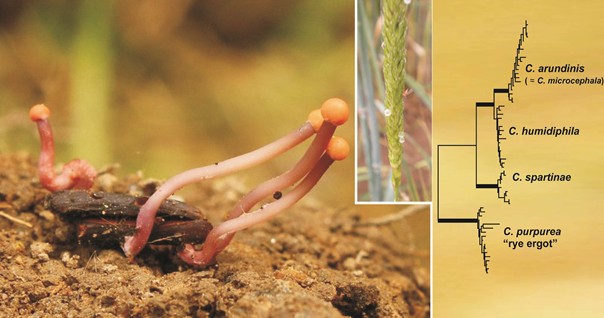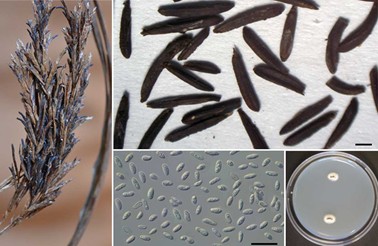






Web design by Martin Kostovcik, 2010













Improving determinations tools in Aspergillus

Phylogeny and speciation processes inside the genus Claviceps encompassing causal fungi of ergot
The genus Claviceps (Ascomycota, Hypocreales) known as the cause of ergot of grasses and cereals contains over 50 species parasitic in the inflorescences of Poales. Most of the species are distributed in the subtropics and tropics. Only Claviceps purpurea and three closely related species, all producing peptide ergot alkaloids, are found in the temperate regions. Whereas the tropical species have narrow range of host grasses, sometimes even restricted to a single host genus, C. purpurea is capable of colonizing the florets of all members of the subfamily Pooideae.
Dr. Sylvia Pažoutová spent his professional life with work on ergot. She suddenly passed away in Sept. 2013 and we are continuing in here work. See other imformation about ergot fungi on Sylvia´s personal web page <http://www2.biomed.cas.cz/~pazouto/pazouto.htm>
Our research aims (Project supported by Czech Science Foundation (GACR, 13-00788S):
- The revision of C. purpurea species with regard to divergence and speciation processes occurring within the taxon.
- The description of new Claviceps species based on DNA sequences and morphological markers (in collaboration with Elna van der Linde, Pretoria)
- The reconstruction and dating of the evolutionary history of the genus Claviceps based on multigene analysis.
Dr. Sylvia Pažoutová spent his professional life with work on ergot. She suddenly passed away in Sept. 2013 and we are continuing in here work. See other imformation about ergot fungi on Sylvia´s personal web page <http://www2.biomed.cas.cz/~pazouto/pazouto.htm>
Our research aims (Project supported by Czech Science Foundation (GACR, 13-00788S):
- The revision of C. purpurea species with regard to divergence and speciation processes occurring within the taxon.
- The description of new Claviceps species based on DNA sequences and morphological markers (in collaboration with Elna van der Linde, Pretoria)
- The reconstruction and dating of the evolutionary history of the genus Claviceps based on multigene analysis.

Sexual stage of Claviceps purpurea germinating from sclerotium (foto by J. Geisler).This species is the most important member of the genus, because of its broad host range and toxicity. Recent molecular genetics studies have indicated that it included three cryptic species (G1, G2, G3). Our aim was to revise C. purpurea species with regard to divergence and speciation processes occurring within the taxon. In our study, reproductive isolation amongst G1-G3 groups and among material from Phragmites and Molinia was tested using gene flow statistics for five polymorphic loci, and to support these data, phylogenetic affiliations based on gene trees and a multigene phylogeny were used. The four recognized species are characterized based on morphology and host spectrum and formal taxonomic names are proposed. Claviceps purpurea sensu stricto (G1 group) represents a typical rye ergot, but infects various other grasses. Typical hosts of Claviceps humidiphila (new name for G2 species), like Phalaris arundinacea, belong to grasses preferring humid locations. Claviceps spartinae (G3) is specific to chloridoid grasses from salt marches. The material from Phragmites and Molinia can be authenticated with the species Claviceps microcephala for which we proposed the new name Claviceps arundinis.

Undescribed species of Claviceps from Fimbriystilis found in South Africa by Elna van der Linde. This toxinogenic species from C. purpurea group is part of the recent revision of South African ergots.